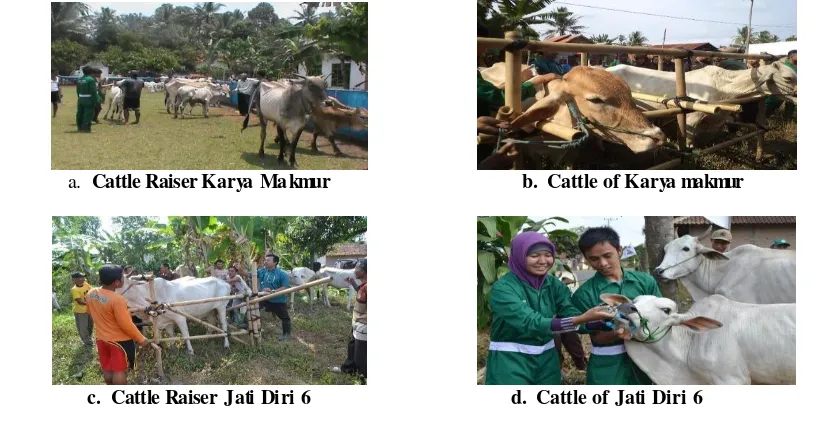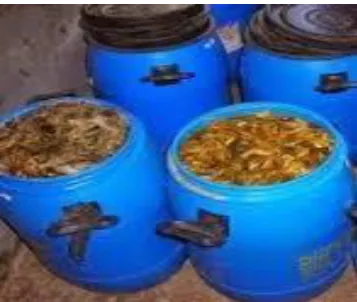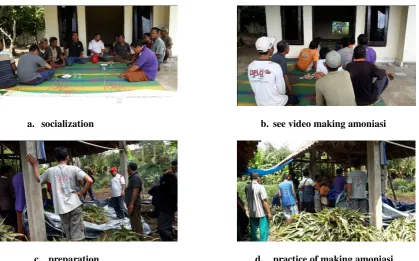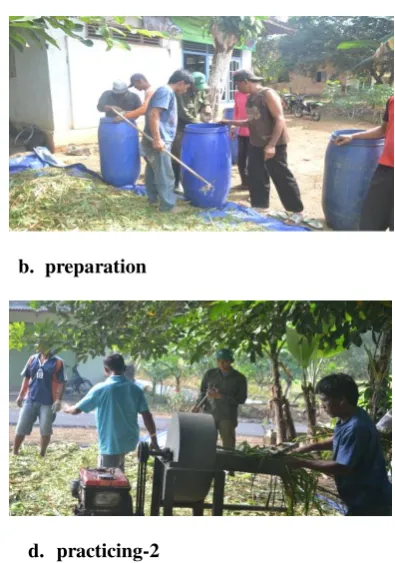Volume 1 Number 2
p-ISSN: 2549-1849 | e-ISSN: 2549-3434
http://jurnal.unimed.ac.id/2012/index.php/jcrs/article/view/9337
THE TECHNOLOGY INDUCTION FOR PREVENTING LIVESTOCK OF
ANIMAL FEED FARMER GROUPS IN DISTRICT OF EAST LAMPUNG
Sri Ratna Sulistiyanti
1*, Madi Hartono
2, Agung Kusuma Wijaya
21Faculty of Engineering, Universitas Lampung, Bandar Lampung, Indonesia 2Faculty of Agriculture, Universitas Lampung, Bandar Lampung, Indonesia
*Corresponding Author: sriratnasulistiyanti@gmail.com
Abstract
The common problem of livestock is abundant greenery during the rainy season and shortages in the dry season. The condition is bad for the health and productivity of livestock Preservation of animal feed technology is conducted by a team from Institute of Research and Community Service (LPPM) of Universitas Lampung, in Toto Mulyo Village, Way Bungur District, East Lampung. The purpose of the processing and preservation of forage feed source of fiber is to utilize forage in the rainy season, maintain the quality of forage, overcome the difficulty of forage in the dry season, improve the quality of forage fiber sources that have low nutrient content. Preservation technique is made silage (to maintain the quality of forage), while to improve the forage quality is done by fermentation and amoniation. The activities were carried out with the design of preserved livestock feeding equipment, training on the use and care of targeted farmer groups (Karya Makmur and Jati Diri 6), group management assistance, the handover of the preserved animal feed technology package, and formed a pilot group. The result of community service is a package of livestock feed preservation technology (silage and ammoniasi).
Keywords: ammoniation, livestock feed preservation, fermentation, productivity, silage
1. INTRODUCTION
The Toto Mulyo village has an area of 550 ha with a population of 2,141 inhabitants is the result of the population census in 2010. The area is still dominated by agricultural land suitable for 290 hectares of rice paddies, while others are settlements of 74 Ha, 10 Ha plantations, 50 ha of swamps, 30 ha swamps and 23 ha of village land.
The types of livelihoods of the villagers vary, such as 359 farmers, 216 farm laborers, 40 entrepreneurs, 14 public servants, 12 craftsmen, 20 merchants, 200 farmers, 2 medical workers. Breeders occupy the 3rd position in the livelihood of the people of Toto Mulyo Village. Thus, it takes a large amount of animal feed. (An overview of cattle ranches in Toto MulyoVillage can be seen in Figure 1).
a. Cattle Raiser Karya Makmur b. Cattle of Karya makmur
c. Cattle Raiser Jati Diri 6 d. Cattle of Jati Diri 6
Figure 1.1 Livestock at Desa Toto Mulyo
Forage is the main feed ingredient for livestock and ruminant livestock (cattle, buffaloes, goats and sheep). One of the important factors that must be considered to improve the productivity of livestock is the provision of forage materials throughout the year, both the quality and quantity sufficient to meet the needs of animal feed substances are useful for basic living livestock (maintenance), production (production), reproduction and power producer (energy) on the worker's cattle.
In Indonesia, forage generally obtained from various sources, among others, from the harvest itself, the edges of roads, roadsides, rice fields, forest edges, graveyard fields, plantations, agricultural residues and so on so that continuous production, quantity and quality are not guaranteed as fodder. In general, breeders, especially in the tropics, especially in Indonesia depend on forage availability of cattle from nature and the remnants of agricultural products.
Forage for food derived from nature (weeds) without special maintenance will have a low production of 30 tons per hectare per year (without fertilization) and 100 hectares per hectare per year (fertilized) are also low nutritional value, so it is necessary to take action to increase production and the quality is by way of maintenance and cultivation of superior grass.
The superior grass as one of the livestock feeds is not well known to most farmers, except in some cattle companies and related government agencies. Whereas the provision of forage feeds continuously in sufficient quantities and high nutritional value is needed in every livestock business. The availability of forage feed is strongly influenced by the seasons, where the rainy season is available in abundance and abundant, while in the dry season its availability is very limited. To overcome this usually breeders give the remnants of agricultural produce such as straw.
Rice straw is one of the large amount of agricultural waste and has not been fully utilized. The production of rice straw varies from 12 to 15 tons per hectare of one harvest or 4-5 tons of dry matter depending on the location and type of rice varieties used. The main obstacles to the utilization of rice straw as one of the animal feed ingredients are high crude fiber content and protein and low digestibility. For that, rice straw needs to be increased the nutritional value by processing, both physical, chemical and biological.
Based on the source of forage can be classified into 3 groups, namely: 1. Graminae (grass).
2. Legume nose (beans). 3. The remaining crops
The purpose of processing and preservation of forage fiber feed source is: 1. Utilize the forage of abundant feed in the rainy season
2. Maintaining the quality of forage
3. Overcoming forage difficulties during the dry season
Improve the quality of forage fiber sources that have nutritional content low.
2. FORMULATION OF PROBLEM
The common problem of people's livestock (in this case Toto Mulyo Village community, Way Bungur Subdistrict, East Lamtim District) is a forage feeding material experiencing the abundant condition during rainy season or lack of quality and decreasing during dry season. The condition is very influential on the health and productivity of livestock. Based on the results of coordination with partners, the main priority is how to maintain the quality of forage that can use the technique of preservation of the forage silage feed, while to improve the quality of forage feed is done by fermentation and amoniasi.
Preservation of animal feed technology into value-added products is done by Institution of Research and Community Service (LPPM) of Universitas Lampung, in Desa Toto Mulyo, District Way Bungur, East Lampung. This is done with the consideration that the people of Desa Toto Mulyo often find it difficult to feed in the dry season. For that activity Dissemination of Food Preservation Technology Products aimed at Farmer Group of Livestock in that location.
3. THEORITICAL FRAMEWORK
a. Silage
Silage is a forage storage technology in fresh condition with high moisture content as a result of preservation forage of fodder or other ingredients through a fermentation process assisted by microorganisms in anaerobic condition (without oxygen) using preservative or without preservative. In plantation and agricultural areas, the amount of agricultural and plantation waste production is very abundant, especially straw, both corn stalks, rice straw, and the straw of nuts and fresh leaves such as cassava leaves, sugar cane or palm leaves and coconut leaves. However, all feed ingredients have not been optimally utilized for animal feed and many are thrown away and in some places only burned. The basic principle of making silage accelerates the occurrence of anaerobic and acidic conditions in a short time. There are three important things about the condition to remove the air quickly, produce lactic acid in lowering the pH, prevent the entry of oxygen into the silo and inhibit the growth of fungus during storage. For the storage process requires a place called a silo, for example turbular silos (Figure 2).
Figure 2. Turbular silos of silage
b. Ammoniation
Ammonia is a chemical treatment process using ammonia (NH3) as a chemical used to improve the digestibility of fibrous feed materials while increases N levels (protein). It has the following advantages: simple, easy to do, cheap (NH3 source taken from urea), as well as preservatives, anti aflatoxin, does not pollute the environment and efficiently (can increase digestibility up to 80%). Ammonia can cause changes in the composition and structure of the cell wall so as to free the bond between lignin with cellulose and hemicellulose, thus facilitating digestion by cellulose rumen microorganisms. The ammonia will be absorbed and bind to the acetyl group from the feed material, then from the ammonium acetate salt, which eventually counts as the protein of the material.
This ammonia processing technology is really easy to implement and is not harmful at all in the process (although it is called chemical processing). Anyone can do the origin to clearly understand which principles and methods to do (wet or dry method). Compared with the processing of other chemical means, the cost is much cheaper.
4. PURPOSE
Dissemination of Food Preservation Technology Product is aimed at Livestock Farm Group at that location. The purpose of processing and preservation of forage feed fiber sources are:
1. Utilizing forage of abundant feed in the rainy season 2. Maintaining the quality of forage feed
3. Overcoming the difficulty of forage in the dry season
4. Improving the quality of forage fiber sources that have low nutrient content.
The specific purpose is livestock is not lack of nutrients in the dry season, so that productivity is maintained.
5. METHOD
To realize at the previous point, then the work procedures undertaken by the activity team are:
1. Receive dissemination information of Technology Products to Community 2. Coordination with the Implementing Team
3. Coordinate with partners
4. Preparation of materials for making tools
5. Training and counseling about silage and ammonia to the target group 6. Training tool maintenance to the target group
10. Handover of equipment
Participating partners in this activity are: 1. Provide training location
2. Provide animal feed ingredients to be processed 3. Provide a cattle feed processing facility 4. Provide manpower
5. Organize group management
6. Evaluate the program implementation and program sustainability
In general, evaluation activities will be conducted in three forms, namely the initial evaluation, process evaluation, and final evaluation activities. Initial evaluation will be undertaken at the beginning of the activity, with a view to obtaining a complete picture of the initial conditions of the knowledge level and understanding of the participants. Evaluation of the process will take place on the stage of establishing a pilot unit. This evaluation is done with the aim to know and overcome the problems faced. As an indicator of success is the creation of preserved animal feed products (so it can meet the needs of livestock feed during the dry season), and increased knowledge and abilities
The final evaluation of the activity is done at the end of the activity program, with a view to know the amount of increased knowledge and understanding achieved. The indicator of its success is the adoption of 80% technology of continuous feed ingredient feed ingredients.
6. RESULTS
This activity includes some steps, as described previously. Therefore the results can be described based on the results of the activities.
Ammoniation was performed on this activity, using 10 tons of raw materials, consisting of corn stalk, godot grass, straw and other forage. Training activities and ammoniation making can be seen in Figure 3.
Silage that can be made as much as 5 tons (36 drums, 150kg raw material / drum). And training activities and silage making can be seen in Figure 4.
a. socialization b. see video making amoniasi
c. preparation d. practice of making amoniasi
a. raw material b. preparation
c. practicing-1 d. practicing-2
Fig. 4. Training activities and silage making
a. preparation b. signing handover technology package 1
c. signing handover technology package 2 d. examples of silage activity results
Fig. 5. Activities handover technology package
7. CONCLUSION
We have finished community service activity about how to make cattle feed preservation using silage and amoniation. So that in the dry season or at the time could not take fresh forage, livestock is not a lack of nutrients..
ACKNOWLEDGMENT
Thanks to Directorate General of Research and Development, Ministry of Technology Research and Higher Education who has provided community service fund through the scheme Dissemination of Technology to The Community in 2017.
REFERENCES
Muhtarudi n, Liman dan Widodo, Y. 2003. Buku Ajar Ilmu Tanaman Pakan. Jurusan Peternakan FP, Unila. Lampung.
Tillman AD, Hartadi H, Reksohadiprodjo S, Praw irokusumo S, Lebdosoekodjo S. 1998. Ilmu Makanan Ternak Dasar. Yogyakarta: Gadjah Mada University Press.



